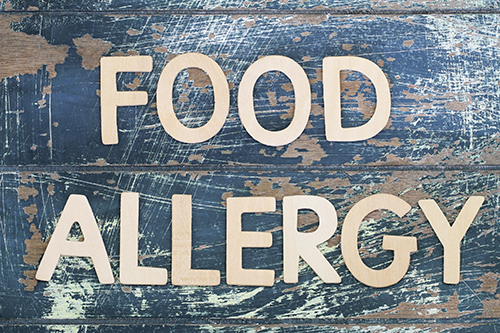Food businesses and their staff need more training to better manage the expectations of the FreeFrom customer
A year ago the European Union enacted EU1169 requiring that all food served directly to consumers – pre-packaged and unpackaged – list any of the 14 food allergens they contained. Our friends at Food Allergy Training Consultancy (FATC) wanted to see how the freefrom community thought food service business were doing in meeting the regulations for allergy labelling in the European Union. Below are the results from the survey they did, reprinted with permission from Food Allergy Aware.
Since the European Union introduced the Food Information Regulations (FIR), we were wondering how safe are freefrom customers when dining out?
[pullquote]“The places that do bother I have had some great experiences, nothing was too much trouble for them, so (I) tend to go back where I know can safely eat.”[/pullquote]An online survey was carried out by Food Allergy Training Consultancy (FATC) in October 2015 to find out how the introduction of NEW Food Information for Consumers regulation (FIC) has affected the food allergy, coeliac and food intolerant community when dining out. The new law means that food service businesses are now required to provide information on the 14 major allergens listed within the regulations.
With the survey, FATC wanted to gain an understanding on how confident the freefrom customer is when dining out since the introduction of the FIC regulations 10 months prior.
There was a range of respondents with special diets, including 23 with food allergies, 61 with coeliac disease and 32 with food intolerance’s. FATC asked a variety of different questions to capture both positive and negative reactions, requesting the respondents to tick which was appropriate to their personal experiences. We offered opportunities at each question for a comment to be given.
Allergy information
Of those questioned 36 percent found the allergy information given was confusing and difficult to understand, with 21 percent being given conflicting information and 35 percent spotting errors on allergen information which did not give them confidence in the venue.[pullquote align=”right”]“Companies are putting the measures in place but I find most servers have never encountered the situation so that training has never been put in place.”[/pullquote]
The chart below shows a small percentage felt the accuracy of written & verbal information supplied was excellent, with 44 percent feeling that verbal communication given was poor. Businesses have a choice in how they supply allergen information, either verbal or documented, however, it would appear from responses and comments that written information would be a preferred method over verbal for quality and accuracy.
Feedback
From comments received many freefrom customers believed that venues that are part of a large chain would be more accurate when supplying written documented allergy information, due to the size of their business with processes and guidance given by their head office. However, this was not always the case, as some would appear to fall down with lack of staff training, inadequate levels of understanding of their menus, inaccurate allergen information and poor management of the freefrom customer service.
Gluten-free Menus
Gluten free menus are now more widely accessible, but from the data compiled 83 percent of respondents who eat out gluten-free felt the choices available were still limited. And, where a specific gluten-free menu was offered, 59 percent felt that staff did not understand their requirements or have a basic knowledge on cross contamination.
[quote]I don’t see any difference to be honest. Nine out of 0 venues still don’t know what gluten is. Lots of them think it is something to do with dairy products and someone event told me that they only have gluten free ginger when I asked for a sandwich in a leading coffee shop.[/quote]Overall, 57 percent of those eating out with a gluten free diet did NOT feel safe when dining out since the allergy labelling changes came into effect.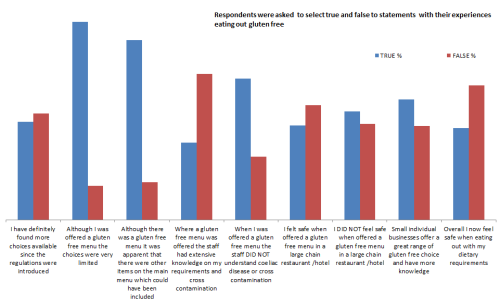
Dairy-free Diets
Those questioned who had a dairy allergy or lactose intolerance, 51 percent found caterers mistakenly thought eggs to be within this category, with 61% often finding it difficult to find a dessert to suit the dietary needs. With only 24 percent stating that businesses were able to provide accurate information relating to their specific diet.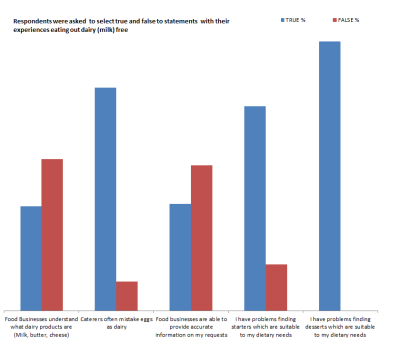
Dairy-free in the UK
A YouGov report from September 2014 found that eight percent of the population, that’s 12 percent of UK households, believe they had a dairy intolerance or had a dairy allergy. Whilst only seven percent of the population, 10 percent of UK households had an issue with wheat or gluten, but caterers are still failing to provide for the dairy- (milk) free customer. This ‘special’ dietary requirement is growing. Lactose intolerance in adulthood is most prevalent in people of East Asian descent, affecting more than 90 percent of adults in some of these communities. Lactose intolerance is also very common in people of West African, Arab, Jewish, Greek, and Italian descent.
The Nut free diner – ‘May Contains’ an issue?
The nut-free diner responses shows that there has been no difference in the number of choices available since the introduction of the FIC. This could be in part due to the ‘May Contains’ labelling which is not currently covered under the regulations. Many businesses find ‘May Contains’ labelling confusing and a grey area even when they do not have nuts on the premises. With many businesses using the term “they can’t guarantee 100%…..” that dishes will not contain their specified allergens. From those questioned there is still a very limited choice available, and 20 percent found some business were even reluctant to serve them.
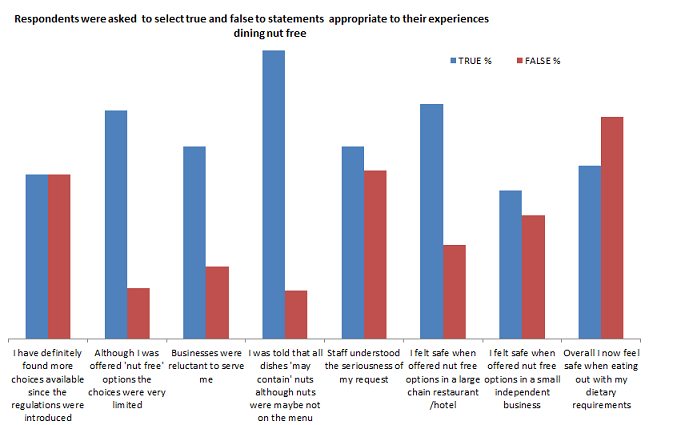
Staff knowledge on allergens Chains vs small businesses
When we asked about staff knowledge on allergens in large chains compared to small individual food businesses, the smaller individual businesses seemed to fair better than chains in the higher ratings.
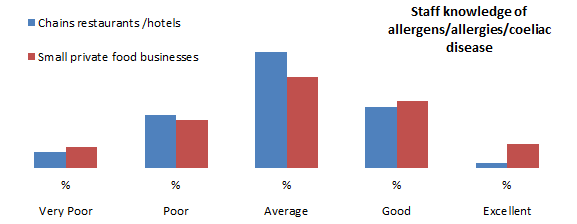
Staff understanding on cross contamination
Chain restaurants again lagged behind the smaller businesses in the good and were just behind for the excellent rating of understanding cross contamination.
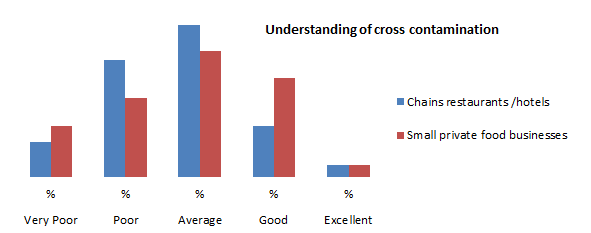
Conclusions
Overall, from all respondents taking part, only 38 percent felt safe when eating out since the changes, (making) it is apparent that food businesses need to have more basic training to ensure staff within both chains and small businesses have better knowledge in place to manage the expectations of the FreeFrom customer.
The data from the report highlights there is a variance of knowledge and understanding of handling and communicating allergens and a lack of urgency and importance of getting it right. Thirteen percent of respondents thought venues had a good understanding and only three percent thought they had an excellent understanding with higher percentage at average and lower understanding. The data clearly identifies that the quality of allergen information needs to improve and with clarification on the use of the term ‘May Contains’ when used on both pre-packed and non-prepacked foods.
[quote]“For me it’s about the awareness and practically of cross contamination. they can have excellent allergy info, etc. but if they’ve careless when preparing or cooking the food then they allergy info is worthless. I’ve been ‘glutened’ more times since allergy info introduced.”[/quote]Personally, on my travels over the last few months I have had to contact five different venues and have found four out of five to have incorrect allergen information, one local to home had at least 15 errors. The venues included two major hotel chains and a leading education establishment. The errors were blatant mistakes, where allergens where left of or included just in case! The impression that was given is that the tables had been thrown together on the day with no checks! We emphasis that a second person should always sanity check the allergen information supplied before it gets presented to the customer. We understand that mistakes can be made, but if a process of auditing is in place then errors can be eliminated before a customer escape happens.
Click here to download for FREE our excel colour coded allergen table, the table helps to identify how dishes can be adapted leaving out or removing products with allergens. It can also highlight the may contains labelling giving the customer an option to choose if they can eat a product safely.
If you would like further information from the full report and to see further comments please contact Caroline by email consultancy@fatc.co.uk.
As the FATC study shows, allergy labelling in the European Union still needs some work a year later. And, as I personally have experienced here in the US, the issue continues to be an issue. A bright light is the Food Labeling Modernization Act of 2015 introduced in late November that will require major food allergens to be listed adjacent to non-packaged foods being offered for sale at retail. We’ll be keeping an eye on the Act as it progresses through committee work and voting to report how it will effect meetings in the United States.


